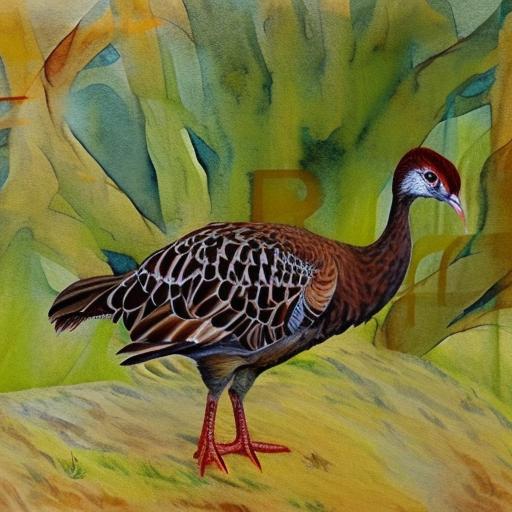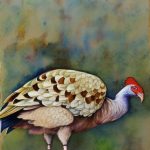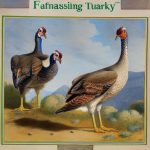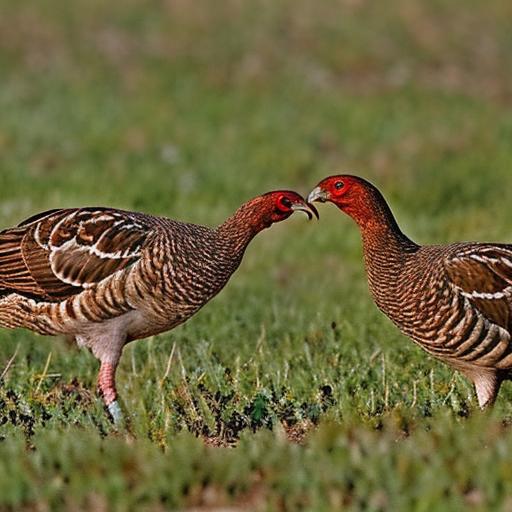Wild turkeys are large birds native to North America and are a popular game bird for hunters. They are known for their distinctive fan-shaped tails and wattled necks. There are six subspecies of wild turkeys, each with its own unique characteristics and habitat. These subspecies include the Eastern wild turkey, the Osceola wild turkey, the Rio Grande wild turkey, the Merriam’s wild turkey, the Gould’s wild turkey, and the Ocellated wild turkey. Each subspecies has its own range and specific traits that make it distinct from the others. In this article, we will explore each of these subspecies in detail, including their physical characteristics, habitat, behavior, and conservation status.
Key Takeaways
- Wild turkeys are native to North America and are known for their large size and distinctive plumage.
- The Eastern wild turkey is the most widespread and populous subspecies, found in the eastern United States and parts of Canada.
- The Osceola wild turkey, also known as the Florida wild turkey, is found only in the state of Florida and is known for its dark plumage.
- The Rio Grande wild turkey is found in the central plains states and parts of Mexico, known for its lighter plumage and adaptability to open terrain.
- The Merriam’s wild turkey is found in the mountainous regions of the western United States, known for its white-tipped tail feathers and preference for higher elevations.
The Eastern Wild Turkey
The Eastern wild turkey (Meleagris gallopavo silvestris) is the most widespread and populous of all the wild turkey subspecies. It is found in the eastern United States and parts of Canada, and is known for its dark, iridescent plumage and large size. The Eastern wild turkey prefers mature forests with a mix of hardwoods and open areas for foraging. It is a highly adaptable bird and can be found in a variety of habitats, from swamps and marshes to mountainous regions. The Eastern wild turkey is an important game bird and is highly sought after by hunters for its large size and challenging behavior. Conservation efforts have helped to increase the population of Eastern wild turkeys in recent years, but habitat loss and hunting continue to pose threats to their survival.
The Eastern wild turkey is known for its impressive size, with adult males, or toms, weighing up to 24 pounds and standing over three feet tall. They have a distinctive fan-shaped tail and a bare head with a fleshy wattle that hangs from their neck. The Eastern wild turkey is a social bird and lives in flocks, with dominant males establishing territories and mating with multiple hens. They are omnivorous and feed on a variety of foods, including acorns, seeds, insects, and small reptiles. The Eastern wild turkey is an important part of the ecosystem, as it helps to control insect populations and spreads seeds through its droppings. Conservation efforts have focused on preserving and restoring suitable habitat for the Eastern wild turkey, as well as regulating hunting to ensure sustainable populations.
The Osceola Wild Turkey
The Osceola wild turkey (Meleagris gallopavo osceola) is a subspecies of wild turkey found exclusively in the state of Florida. It is named after the famous Seminole chief Osceola and is also known as the Florida wild turkey. The Osceola wild turkey is smaller and darker than the Eastern wild turkey, with a more limited range and specific habitat requirements. It is found in the peninsula of Florida, where it inhabits cypress swamps, pine flatwoods, and hardwood forests. The Osceola wild turkey is an elusive bird and is highly prized by hunters for its challenging behavior and limited range.
The Osceola wild turkey is known for its dark plumage with a greenish sheen and small white bars on its wings. Adult males can weigh up to 20 pounds and have long spurs on their legs used for defense and mating displays. The Osceola wild turkey is a wary bird and is known for its keen eyesight and ability to detect danger. It is a vocal bird and communicates through a variety of calls, including gobbles, clucks, and purrs. The Osceola wild turkey plays an important role in the ecosystem of Florida, as it helps to control insect populations and spread seeds through its droppings. Conservation efforts have focused on preserving suitable habitat for the Osceola wild turkey, as well as regulating hunting to ensure sustainable populations.
The Rio Grande Wild Turkey
The Rio Grande wild turkey (Meleagris gallopavo intermedia) is a subspecies of wild turkey found in the central plains of the United States and parts of Mexico. It is named after the Rio Grande river, which forms part of its range, and is known for its lighter plumage and adaptability to open grasslands and agricultural areas. The Rio Grande wild turkey is an important game bird and is highly sought after by hunters for its challenging behavior and impressive size.
The Rio Grande wild turkey is known for its light brown plumage with coppery iridescence and small white bars on its wings. Adult males can weigh up to 25 pounds and have long spurs on their legs used for defense and mating displays. The Rio Grande wild turkey is a social bird and lives in flocks, with dominant males establishing territories and mating with multiple hens. They are omnivorous and feed on a variety of foods, including grasses, seeds, insects, and small reptiles. The Rio Grande wild turkey plays an important role in the ecosystem of the central plains, as it helps to control insect populations and spread seeds through its droppings. Conservation efforts have focused on preserving suitable habitat for the Rio Grande wild turkey, as well as regulating hunting to ensure sustainable populations.
The Merriam’s Wild Turkey
The Merriam’s wild turkey (Meleagris gallopavo merriami) is a subspecies of wild turkey found in the mountainous regions of the western United States. It is named after Hart Merriam, an early American ornithologist, and is known for its light plumage and preference for high-altitude habitats. The Merriam’s wild turkey is an important game bird and is highly sought after by hunters for its challenging behavior and impressive size.
The Merriam’s wild turkey is known for its light gray plumage with white tips on its tail feathers and small white bars on its wings. Adult males can weigh up to 23 pounds and have long spurs on their legs used for defense and mating displays. The Merriam’s wild turkey is a social bird and lives in flocks, with dominant males establishing territories and mating with multiple hens. They are omnivorous and feed on a variety of foods, including grasses, seeds, insects, and small reptiles. The Merriam’s wild turkey plays an important role in the ecosystem of the western mountains, as it helps to control insect populations and spread seeds through its droppings. Conservation efforts have focused on preserving suitable habitat for the Merriam’s wild turkey, as well as regulating hunting to ensure sustainable populations.
The Gould’s Wild Turkey

The Gould’s wild turkey (Meleagris gallopavo mexicana) is a subspecies of wild turkey found in the mountainous regions of northern Mexico and parts of the southwestern United States. It is named after J. Gould, an early American ornithologist, and is known for its impressive size and distinctive white tips on its tail feathers. The Gould’s wild turkey is an important game bird and is highly sought after by hunters for its challenging behavior and limited range.
The Gould’s wild turkey is known for its dark plumage with coppery iridescence and white tips on its tail feathers. Adult males can weigh up to 26 pounds and have long spurs on their legs used for defense and mating displays. The Gould’s wild turkey is a social bird and lives in flocks, with dominant males establishing territories and mating with multiple hens. They are omnivorous and feed on a variety of foods, including grasses, seeds, insects, and small reptiles. The Gould’s wild turkey plays an important role in the ecosystem of the mountainous regions where it is found, as it helps to control insect populations and spread seeds through its droppings. Conservation efforts have focused on preserving suitable habitat for the Gould’s wild turkey, as well as regulating hunting to ensure sustainable populations.
The Ocellated Wild Turkey
The Ocellated wild turkey (Meleagris ocellata) is a species of wild turkey found in the Yucatán Peninsula in Mexico, Belize, and Guatemala. It is named after the distinctive eye-shaped spots on its tail feathers, called ocelli, which are unique among all other species of turkeys. The Ocellated wild turkey is smaller than other species of turkeys, with adult males weighing up to 11 pounds.
The Ocellated wild turkey has iridescent plumage with shades of green, blue, copper, and bronze that change color depending on the angle of light hitting their feathers. They have bright blue heads with orange or red waddles that become engorged during courtship displays. The Ocellated wild turkey prefers dense tropical forests with a mix of open areas for foraging. They are omnivorous birds that feed on fruits, seeds, insects, small reptiles, and amphibians.
The Ocellated wild turkey plays an important role in the ecosystem of the Yucatán Peninsula by helping to disperse seeds through their droppings and controlling insect populations. Conservation efforts have focused on preserving suitable habitat for the Ocellated wild turkey due to habitat loss from deforestation and hunting pressures.
In conclusion, each subspecies of wild turkeys has its own unique characteristics that make it distinct from the others. From the Eastern wild turkey’s widespread population to the Ocellated wild turkey’s limited range in Central America, these birds play an important role in their respective ecosystems. Conservation efforts are crucial to ensuring the survival of these magnificent birds for future generations to enjoy both in their natural habitats and as part of sustainable hunting practices.
If you’re interested in learning more about wild turkeys, you might also enjoy reading about the different breeds of domestic poultry. PoultryWizard.com has a fascinating article on the Snaplock Chicken Coop, which provides valuable insights into creating a safe and comfortable environment for your chickens. Check it out here.
FAQs
How many breeds of wild turkeys are there?
There are six recognized subspecies of wild turkeys in North America: Eastern, Osceola (Florida), Rio Grande, Merriam’s, Gould’s, and the South Mexican (also known as the Mexican wild turkey).
What are the differences between the breeds of wild turkeys?
The different breeds of wild turkeys have variations in size, coloration, and habitat preferences. For example, the Eastern wild turkey is the most widespread and populous, while the Gould’s wild turkey is the largest and has distinct white tips on its tail feathers.
Where can the different breeds of wild turkeys be found?
The Eastern wild turkey is found in the eastern United States and parts of Canada, while the Osceola (Florida) wild turkey is found only in the state of Florida. The Rio Grande wild turkey is found in the central plains states, the Merriam’s wild turkey is found in the mountainous regions of the western United States, and the Gould’s wild turkey is found in the mountainous regions of northern Mexico and the southwestern United States.
Are there any other species of wild turkeys outside of North America?
No, wild turkeys are native to North America and are not found in any other part of the world.
Meet Walter, the feathered-friend fanatic of Florida! Nestled in the sunshine state, Walter struts through life with his feathered companions, clucking his way to happiness. With a coop that’s fancier than a five-star hotel, he’s the Don Juan of the chicken world. When he’s not teaching his hens to do the cha-cha, you’ll find him in a heated debate with his prized rooster, Sir Clucks-a-Lot. Walter’s poultry passion is no yolk; he’s the sunny-side-up guy you never knew you needed in your flock of friends!







